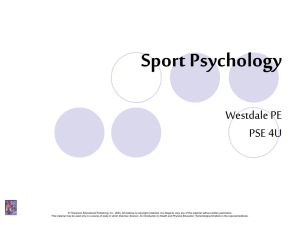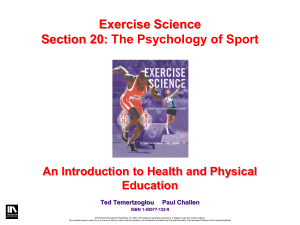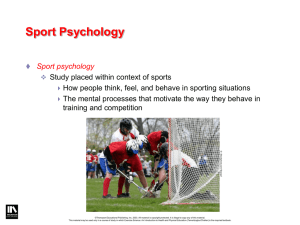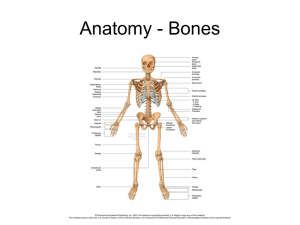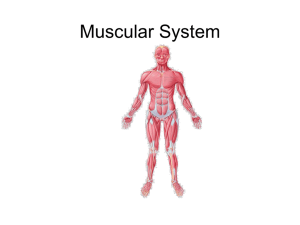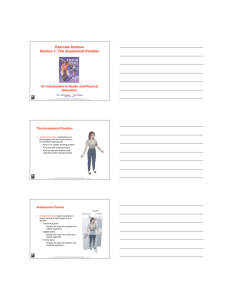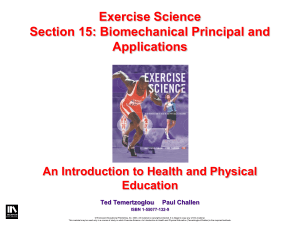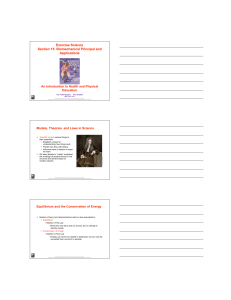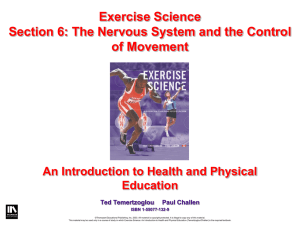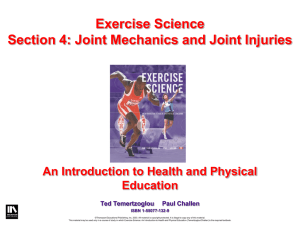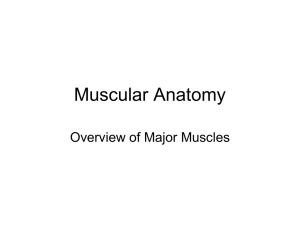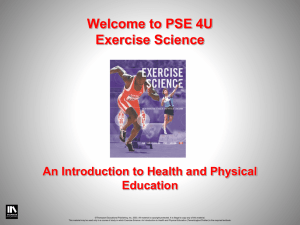Exercise Science
advertisement
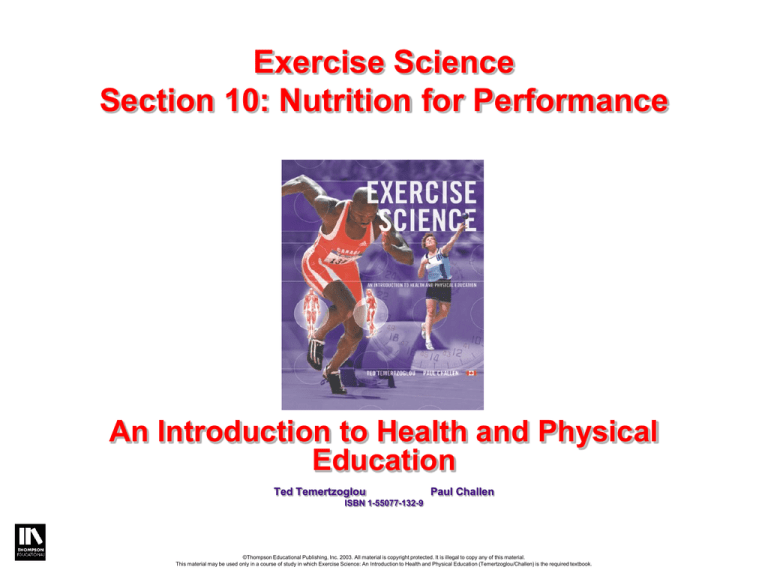
Exercise Science Section 10: Nutrition for Performance An Introduction to Health and Physical Education Ted Temertzoglou Paul Challen ISBN 1-55077-132-9 ©Thompson Educational Publishing, Inc. 2003. All material is copyright protected. It is illegal to copy any of this material. This material may be used only in a course of study in which Exercise Science: An Introduction to Health and Physical Education (Temertzoglou/Challen) is the required textbook. Food Categories Macronutrients Direct sources of energy Carbohydrates Proteins Fats Micronutrients Act as co-agents in ©Thompson Educational Publishing, Inc. 2003. All material is copyright protected. It is illegal to copy any of this material. This material may be used only in a course of study in which Exercise Science: An Introduction to Health and Physical Education (Temertzoglou/Challen) is the required textbook. © iStockphoto.com/”mrPliskin” bioenergetic process Vitamins Minerals Proteins ©Thompson Educational Publishing, Inc. 2003. All material is copyright protected. It is illegal to copy any of this material. This material may be used only in a course of study in which Exercise Science: An Introduction to Health and Physical Education (Temertzoglou/Challen) is the required textbook. © iStockphoto.com/”Floortje” tissue 4 Calories of energy for each gram of protein Body breaks proteins down into amino acids 20 amino acids Nine amino acids supplied by the foods we eat Essential amino acids Complete proteins (foods containing 20 amino acids) Meat, eggs, cheese, and milk Incomplete proteins (limited amounts of amino acids) Vegetable proteins © iStockphoto.com/”Kativ” Necessary for the growth and repair of body Carbohydrates Most accessible form of ©Thompson Educational Publishing, Inc. 2003. All material is copyright protected. It is illegal to copy any of this material. This material may be used only in a course of study in which Exercise Science: An Introduction to Health and Physical Education (Temertzoglou/Challen) is the required textbook. © iStockphoto.com/”YinYang” energy 4 Calories of energy for each gram of carbohydrate Complex carbohydrates Cereals, fruits, vegetables, legumes, and pasta Simple carbohydrates Sugar Fats Insulate and protect vital parts of the ©Thompson Educational Publishing, Inc. 2003. All material is copyright protected. It is illegal to copy any of this material. This material may be used only in a course of study in which Exercise Science: An Introduction to Health and Physical Education (Temertzoglou/Challen) is the required textbook. © iStockphoto.com/”TomBoy2290” body Release more energy quickly 9 Calories of energy for each gram of fat Saturated fats (“bad fat”) Meat, poultry, butter, lard, hard margarines Higher concentrations of lowdensity lipoprotein (LDL) Polyunsaturated fats Soybean, corn, sunflower, safflower, sesame oils Higher concentrations of highdensity lipoprotein (HDL) Micronutrients Vitamins assist the body in performing several processes: Regulate reactions that occur in metabolism Facilitate energy release Important in the synthesis of bone and tissue Minerals assist the body in acquiring energy from macronutrients Aid in bone and teeth formation; Aid in development of skeletal and connective tissues Aid in muscle and nerve function; building muscle and transmission of nerve impulses Detoxifies the body ©Thompson Educational Publishing, Inc. 2003. All material is copyright protected. It is illegal to copy any of this material. This material may be used only in a course of study in which Exercise Science: An Introduction to Health and Physical Education (Temertzoglou/Challen) is the required textbook. Water Soluble Vitamins ©Thompson Educational Publishing, Inc. 2003. All material is copyright protected. It is illegal to copy any of this material. This material may be used only in a course of study in which Exercise Science: An Introduction to Health and Physical Education (Temertzoglou/Challen) is the required textbook. Fat Soluble Vitamins ©Thompson Educational Publishing, Inc. 2003. All material is copyright protected. It is illegal to copy any of this material. This material may be used only in a course of study in which Exercise Science: An Introduction to Health and Physical Education (Temertzoglou/Challen) is the required textbook. Minerals ©Thompson Educational Publishing, Inc. 2003. All material is copyright protected. It is illegal to copy any of this material. This material may be used only in a course of study in which Exercise Science: An Introduction to Health and Physical Education (Temertzoglou/Challen) is the required textbook. Canada’s Food Guide Canada’s Food Guide to Healthy Eating Provides recommendations for number of servings from the main food groups: Grain Products Vegetables and Fruit Milk Products (now Milk and Alternatives) Meat and Alternatives Eating Well with Canada’s Food Guide Released in 2007 Revision providing nutritional requirements that reflect Canada’s multicultural society ©Thompson Educational Publishing, Inc. 2003. All material is copyright protected. It is illegal to copy any of this material. This material may be used only in a course of study in which Exercise Science: An Introduction to Health and Physical Education (Temertzoglou/Challen) is the required textbook. The Energy Equation Energy equation: the food (or energy) we take in should closely match the effort we put out Energy storage = Energy intake – Energy output ©Thompson Educational Publishing, Inc. 2003. All material is copyright protected. It is illegal to copy any of this material. This material may be used only in a course of study in which Exercise Science: An Introduction to Health and Physical Education (Temertzoglou/Challen) is the required textbook. Basal and Resting Metabolic Rate Metabolic rate (MR) Measures energy that needs to be consumed in order to sustain essential bodily functions Affected by age, sex, weight, lean muscle mass, and general level of physical fitness Two measures are distinguished: Basal metabolic rate (BMR) Measures MR under rigorous conditions Resting metabolic rate (RMR) Measures MR under less rigorous conditions Most common measurement in practice ©Thompson Educational Publishing, Inc. 2003. All material is copyright protected. It is illegal to copy any of this material. This material may be used only in a course of study in which Exercise Science: An Introduction to Health and Physical Education (Temertzoglou/Challen) is the required textbook. Harris-Benedict Equation Harris-Benedict Equation Used to calculate your RMR Separate calculations for males and females Males: RMR = 66.5 + (5H) + (13.7W) – (6.8A)* Females: RMR = 665 + (1.9H) = (9.5W) – (4.7A)* *H = height in centimetres W = weight in kilograms A = age in years ©Thompson Educational Publishing, Inc. 2003. All material is copyright protected. It is illegal to copy any of this material. This material may be used only in a course of study in which Exercise Science: An Introduction to Health and Physical Education (Temertzoglou/Challen) is the required textbook. Nutrition Facts Table The nutrient information is based on a specified quantity of food. This number is the actual amount of the nutrient in the specified quantity of food. The %DV gives a context to the actual amount. It indicates if there is a lot or a little of the nutrient in the specified quantity of food. The Nutrition Facts table must always include this list of Calories and 13 nutrients. ©Thompson Educational Publishing, Inc. 2003. All material is copyright protected. It is illegal to copy any of this material. This material may be used only in a course of study in which Exercise Science: An Introduction to Health and Physical Education (Temertzoglou/Challen) is the required textbook. Body Mass Index Body Mass Index (BMI): Used to assess extent to which a person is balancing the energy equation Ratio of a person’s weight in kilograms to the square of his/her height in metres Correlates with increased risks of disease Does not distinguish between fat and excess muscle ©Thompson Educational Publishing, Inc. 2003. All material is copyright protected. It is illegal to copy any of this material. This material may be used only in a course of study in which Exercise Science: An Introduction to Health and Physical Education (Temertzoglou/Challen) is the required textbook. Obesity Obesity is considered a “chronic” condition Contributing factors include: Activity levels Diet Genetic factors Rates of metabolism Environmental, social, and psychological factors National Institute on Nutrition (Canada) reports there is an 80% chance that a child will become obese if both parents are also obese ©Thompson Educational Publishing, Inc. 2003. All material is copyright protected. It is illegal to copy any of this material. This material may be used only in a course of study in which Exercise Science: An Introduction to Health and Physical Education (Temertzoglou/Challen) is the required textbook. Being Underweight Being underweight (officially designated as a BMI of less than 18.5) is a major health concern One prominent factor associated with being underweight includes a relentless urge for an impossibly lean physique Signs suggestive of an eating disorder include: Preoccupation with food and weight Eating alone Continuous drinking of diet soda and water Trips to the bathroom during or immediately following meals Use of laxatives Compulsive/excessive exercise Increasing criticism of one’s body Expressed concerns about being fat ©Thompson Educational Publishing, Inc. 2003. All material is copyright protected. It is illegal to copy any of this material. This material may be used only in a course of study in which Exercise Science: An Introduction to Health and Physical Education (Temertzoglou/Challen) is the required textbook. Nutrition and Athletic Performance Food Group Athlete 1 Athlete 2 Athlete 3 (divers, synchronized swimmers, and gymnasts) (most athletes) (endurance athlete) Grain Products Minimum 5 servings 8 servings or more 10–12 servings or more Vegetables and Fruit Minimum 5 servings 8 servings or more 8–10 servings or more Meat and Alternatives Minimum 2 servings 2 servings 2–4 servings Milk and Alternatives Minimum 2 servings (teens 3–4 servings) 2 servings (teens 3–4 servings) 2–6 servings (teens 3–6 servings) Extra Foods Minimize extra choices Choose in moderation Choose to meet energy needs Source: Sport Nutrition for the Athletes of Canada ©Thompson Educational Publishing, Inc. 2003. All material is copyright protected. It is illegal to copy any of this material. This material may be used only in a course of study in which Exercise Science: An Introduction to Health and Physical Education (Temertzoglou/Challen) is the required textbook. Dehydration and Fluid Replacement Water is essential for temperature regulation Aids in digestion and in all metabolic activity Makes up 50–60% of overall body weight; 90% of blood plasma by weight Dehydration is a loss of water (and loss of electrolytes) that affects human performance Water best replacement for activities less than 90 minute in duration Replacements (sport drinks) are needed when activities last longer than 90 minutes ©Thompson Educational Publishing, Inc. 2003. All material is copyright protected. It is illegal to copy any of this material. This material may be used only in a course of study in which Exercise Science: An Introduction to Health and Physical Education (Temertzoglou/Challen) is the required textbook. Fluid Replacement Before exercise: Drink 2–3 cups of water 2–3 hours before exercise Drink 1 cup of water 10–20 minutes before exercise During exercise: Drink 1/2 cup of cool fluid after each 10 minutes of exercise Drink a sports beverage (6–8% concentration of carbohydrate) during activity longer than 50 minutes After exercise: Regained fluid loss within 2 hours Drink fluids containing carbohydrates to rebuild glycogen store and electrolytes ©Thompson Educational Publishing, Inc. 2003. All material is copyright protected. It is illegal to copy any of this material. This material may be used only in a course of study in which Exercise Science: An Introduction to Health and Physical Education (Temertzoglou/Challen) is the required textbook. ©Thompson Educational Publishing, Inc. 2003. All material is copyright protected. It is illegal to copy any of this material. This material may be used only in a course of study in which Exercise Science: An Introduction to Health and Physical Education (Temertzoglou/Challen) is the required textbook.
